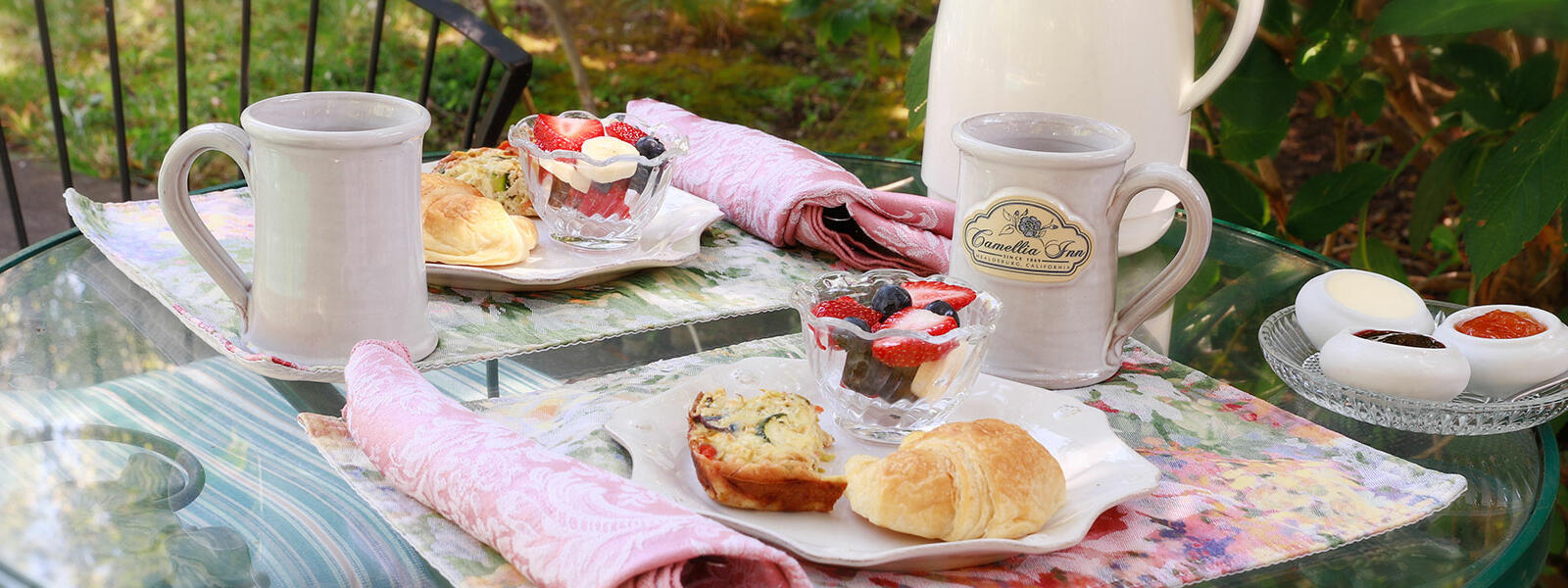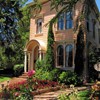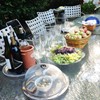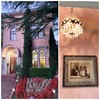Key features
About Us
At the Camellia Inn, your comfort is our priority. You’ll spend your days experiencing the beauty of Sonoma County, from wine tasting to hiking and golfing, you can relax comfortably when you return to the inn. Stroll the grounds and admire the 50 varieties of camellia plants that give the inn its name. Enjoy the villa-style swimming pool, or retire to your room to relax. Breakfast each morning is a seasonal selection of farmers market fresh egg dishes, fruits and bounty from the same earth that thrilled famed horticulturist Luther Burbank and still inspires Sonoma County winemakers.
Common Rooms to Enjoy
The Inn has several different areas for guests to find a quiet corner of their own including two parlors, the dining room, as well as several outdoor spaces.
Evening Happy Hour
The Inn is a charming 1869 Italianate Victorian Inn in California’s Wine Country where Old World vintage charm blends perfectly with modern luxury amenities to provide an affordable Healdsburg bed and breakfast Inn experience. Evenings mean Sonoma County wine and cheese tasting in the elegant parlor or out by the flower-decked pool in warmer months.
The Spa
The idea of getting away from the stress of life and letting your struggles fade away is exactly what we want for you at the Inn Bed and Breakfast. Our Spa can provide you with luxurious spa treatments that will renew the body and soul. Do you want a couple’s treatment? Do you want a girl’s spa in Healdsburg Ca day? These are just two questions to ask yourself when you are thinking about booking a spa day with us. Our Healdsburg Spa is all about you and giving you the very best experience possible. We’ll bring that serene setting when you come to our sun porch that’s rich with period tile floors and a tall ceiling. It’s the perfect location to let all your “cares drift right into space.” Another cool option we offer is to have an individual massage in your room. Just ask, and we’ll make it happen. We offer Reiki massages, Swedish massages, Deep Tissue Massages, a Master’s Massage and a handful of others.
Energy Conservation & Sustainability Our Way of Life
At the Inn, we’re committed to energy conservation and sustainability and have been for as long as we’ve been in business. We’ve had solar water pre-heaters and a solar pool heater for more than 20 years. We use liquid soap in our rooms. We’ve recycled and composted for years. Our linens are 100% eco-friendly and recyclable.
Pool, Gardens & Camellias
Step into complete relaxation outside at our Sonoma Lodging.
Stroll the grounds and admire the 50 varieties of camellia plants that give our Sonoma Lodging its name, then enjoy a dip in the villa-style swimming pool or lounging on the water’s edge.
Camellias at our Sonoma Lodging
Many of these beautiful camellias were already here and flourishing in our Healdsburg gardens in 1981 when the current owners purchased the home to convert to an inn. More than 80 plants bloom throughout the winter on the inn’s landscaped grounds.
Sonoma County was home to American botanist, horticulturist and pioneer in agricultural science Luther Burbank. We understand that Luther Burbank knew Dr. Seawell, who lived and worked in the building that is now the Inn, and that Burbank was responsible for working with the doctor and his wife on the planting of many of the camellias that make up our Healdsburg gardens.
Stroll the grounds and admire the 50 varieties of camellia plants that give our Sonoma Lodging its name, then enjoy a dip in the villa-style swimming pool or lounging on the water’s edge.
The Adored Victorian Camellia
The camellia was arguably the most adored flower of Victorian times. In the Language of Flowers, the camellia stands for "excellence" and "perfect loveliness." Its popularity with the Victorians was practical and romantic. It was unique, had spectacular blooms and came from the Orient. On the practical side, it was an excellent flower that thrived in the badly lit and chilly ambiance of the lady's parlor.
The Camellia's Fall From Grace
Alas, the publishing of the Alexandre Dumas novel, La Dame aux Camelias, led to the camellia's fall from grace among the wealthy upper classes. In the story, a young man has an affair with a courtesan, Marguerite, whose favorite flower is the white camellia. His father ends the affair, and Marguerite dies of tuberculosis. The novel led to the poor camellia being associated with loose women and no longer being welcome in the finest homes.
The Silver Lining:
Fortunately, the decreased prices associated with the flower's loss of popularity allowed the middle-class to discover its beauty and save the flower from infamy.
Sonoma Lodging Garden Tour
Enjoy a little journey through our gardens to view and learn more about some of our favorite plants and garden features. When you come to visit, we invite you to take a self-guided Healdsburg garden tour of the gardens. Info tour sheets are available at the inn and a systematic guide to touring the garden is also available here. In the meantime, enjoy a shorter visual journey below.
Starting at the Fish Pond patio, and facing the tree-lined North Street you’ll see our light and airy Evergreen Dogwood on the left. It is a very rare variety. Lucy Lewand’s sister Chris grew it from seed. Also nearby is the old Oriental Magnolia (Tulip Tree). When Dr. Seawell used the home as the town’s first hospital, his patients delighted in seeing the tree’s cheerful blossoms in the spring, it’s an heirloom dating to the 1820s. Crossing over the brick patio to the right are some of the old Camellias at the Camellia Inn planted by the doctor and his wife. The Lewands have added more than 40 additional varieties of camellias since starting the Inn. Many of the later additions were purchased from or donated by the late Jim Smith, a local artist. He tenderly grafted numerous plants. Some are more than 30 years old. The Japanese Maple was added in 1988 as shade for the camellias.
The Goldfish Pond lies in the center of the patio; a focal point and favorite spot for guests. Peek around the water lilies, to glimpse the glittering scales of goldfish. Built in 1927, the tile and frogs are from the famous Rookwood art pottery company in Ohio. This was the first fishpond in town. All the neighbors attended Mrs. Seawell’s grand unveiling party. A Blue Spruce is just in front of the Fish Pond. Close by is the Sasanqua Camellia with its distinctive serrated leaves and small flowers.
Fragrant rose bushes line the sidewalk, blooms are best from March to July. Two dogwoods at the sidewalk’s edge greet guests as they arrive. One is a white Western Dogwood and the other a Pink Flowering Dogwood. Towering next to the house is a Cedar of Lebanon tree that stands about 65′ tall. This giant was planted around 1870. To the east side of this giant is a graceful Dwarf Japanese Maple.
Along the east boundary of the property a delicate peony grows and next to them is our Prince Albert Camellia. Mrs. Seawell purchased it in the 1940s from a local nursery. A sun-loving rhododendron garden lies in the middle of the front yard. Smaller azaleas add accent. Growing lavishly on the wooden overhang next to the house is a fragrant white wisteria. To the left of the steps, you’ll note a series of pink, white and red Dolores Hope Camellias. They are camellias with exclusively very large blooms (more than 5 inches). variety. They are the most common camellia and are noted for their dense foliage and many different flower shapes.
In the rear of the inn, the pool area is surrounded by stunning flower gardens and trees including a pomegranate tree, lilacs, wisteria, and two tall oaks. Next to the pool, there is a grand crape myrtle and spectacular azaleas lining the fence. Surrounding the pool are bountiful displays of roses and camellias. Looking across from the pool you’ll see trumpet vines creating a beautiful backdrop. Tuberous begonias and ferns also grow along the pool wall, as well as dwarf navel oranges and apple trees.
Breakfast
A fresh, locally grown and delicious Healdsburg Breakfast awaits.
The Inn takes pride in offering the very best rooms, the very best staff, the very best experience, AND the very best Healdsburg breakfast! We believe in supporting our local farmers, ranchers, and local businesses, and do so whenever possible when crafting our Healdsburg breakfast for our guests. Breakfast ingredients are locally-sourced, organic and sustainable, in-season and “right off the farm” fresh. If you’ve never had an egg that wasn’t shipped to a grocery store from far away, eating breakfast at the Inn will be a revelation. Our eggs come from local hens that are well treated, and they’re delivered fresh weekly.
Your Healdsburg Breakfast on Your Terms
At the Inn, we believe in giving you the freedom to start your day as relaxed as you would on a day off at home. Breakfast is served between 8:30am and 10:00am, but, if you need coffee earlier, or a “to go” breakfast, we have that covered too. Sonoma County Wine Country Big River Coffee Company delivers fresh ground organic blend each week. At 8:30am, the dining room opens with lots of first-course choices – fresh fruit, fruit juice smoothies, granola, your favorite breakfast cereals, yogurt, fresh-baked bread from Costeaux’s bakery, and perhaps another breakfast pastry. Our hot entrées of the day are listed on the sideboard and they vary from sweet one day to savory the next. If you are fortunate enough to be able to join us for breakfast on Chocolate Covered Wednesdays, there will also be chocolate on the menu.
A Choice of Breakfast Dining settings
Our main dining room table is available for seating as well as some smaller tables spread around for social distancing. You can enjoy our homestyle breakfast without any intrusions. We are pleased to now offer a breakfast tray that can be delivered to you so you can dine in the privacy of your own room. Enjoy breakfast in your room, out by the pool, or just relax at the main dining table, all options are encouraged. If you’d like a more social setting, our guests are always welcome and encouraged to talk with the staff about anything and interact with any of the other residents. We pride ourselves on being unobtrusive, but if you want to share your plans, ask questions, or get private tasting room passes, we’re always available.
More About Our Healdsburg Breakfast
Do you Share Recipes? We are happy to provide you with any recipe you want so that you can prepare your favorite Inn Breakfast at home.
Special Dietary Requests: With advance notice, we can modify our recipes to meet almost any food allergy and special dietary need you may have. Vegetarian, vegan, gluten-free, or dairy-free. It’s all part of ensuring that your Inn experience is everything you could hope for, and at a better price than anywhere else.
Healdsburg Breakfast “To Go”: Got an early plane, train, ferry, or business meeting? We’ll happily prepare our “Early Breakfast To Go” for you. It includes a croissant breakfast sandwich of your choice, seasonal fruit and to-go cups for coffee to help you get an early start.
Healdsburg & Sonoma County’s Amazing Agricultural Bounty: Although Healdsburg and Sonoma County are known for producing renowned wines, many people don’t know that the terroir (taste of the earth) that is essential to producing those award-winning grapes is also responsible for our amazing agricultural bounty. Not only are fabulous grapes produced here but so much more comes from the soil, the individual farmers and a dedication to sustainability and producing the very best. That best is on display in the wonderful Healdsburg breakfast we craft for guests.
Inn Events
Healdsburg Upcoming Events at the Inn
The Camellia Inn is proud to host several Healdsburg Upcoming Events throughout the year. Visit this page often as we’re always updating it with the newest offers and Healdsburg upcoming events that are happening right here at the inn.
Valentine’s Day picnic plans? Visit the Inn for a special to-go afternoon tea experience! Not only is this a wonderful add-on to an overnight stay, but it’s also adored by neighbors and locals alike and is the perfect Friday surprise for someone special in your life.
We’ll provide all the fixings for an afternoon tea party including:
- selection of gourmet teas
- freshly baked scones with clotted cream and lemon curd
- savoury sandwiches to share
- an assortment of artisan chocolates
- Take it home to enjoy in the comfort of your own home or at a picnic in the park with friends
Our Inn is excited to welcome back chef and Dry Creek Catering owner, Hila Fichtelberg! Hila will lead us in learning and preparing winter delights in the safety and comfort of your own kitchen. Get ready to cook on Thursday afternoons at 4 p.m. PST! Virtual classes include a list of ingredients for each dish and live online instruction via Zoom from Chef Hila.
Inn Rooms
Our Sonoma County Bed and Breakfast Rooms.
Amenities for all Inn Rooms: Full breakfast, Wine & cheese tasting, High-quality mattresses, Luxurious linens & duvets, Complimentary WiFi, Hairdryer, Swimming pool, Walking distance to wineries, and in-room Coffee maker.
Sun Room
Max guests 2 | Full Bed.
The Sun Room is a bright cozy upstairs room in the main house. It has an antique double-size iron bedstead, comfortable armchair and antique dresser from our family home in Michigan. A large, private classic 1920s bathroom with a long tub with shower over it is across a short hallway. A favorite room for guests who are out and about all day wine tasting or bicycling.
Queen Rooms
Max guests 2 | Queen bed.
The Inn's two Queen Rooms are elegant and lovely. They are comfortably appointed and include private bath with shower and in-room sink. Relax in your four-poster or canopy bed dressed with remarkably soft sheets.
Queen Deluxe
Max guests 2 | Queen Bed
Our two Queen Deluxe Rooms are plush and inviting, and feature four-poster beds. Pampering whirlpool tubs or a romantic gas fireplace are available. Two of these rooms have private entrances.
King Deluxe
Max guests 2 | King Bed.
Our three King Rooms are our largest rooms with lovely king-size beds covered in luxurious linens. Pampering whirlpool tubs for two and romantic gas fireplaces, with a relaxing sitting area.
Family Suite
Max guests 3 | 1 Queen + 1 Full Bed.
Our Family Suite includes a full-size Queen room, large bathroom with double sinks, whirlpool tub and a cozy smaller room with a double bed, perfect for a maximum of three adults or one couple with children. Book the suite as a Family Package and enjoy discounts on family activities, and at family restaurants. Families are welcome at the Inn.
Vacation Rentals
Heron House (three miles from the inn).
Permit #1681N | Max guests 8 | Bed(s): 3 queen beds, 1 sofa bed.
Enjoy the Heron House, where the Redwoods meet the Russian River. With direct river access and its own private beach, this very special riverfront home is located just minutes from downtown Healdsburg, yet a world away, nestled on a wooded knoll on North Fitch Mountain, safely above the river.
The Heron House is a 3 bedroom, 2 bath, newly renovated home, inside and out, with a new deluxe queen LA-Z-BOY sleeper sofa with an up-graded ‘air-comfort’ mattress, accommodating up to 8 guests and is child friendly. This lovely cottage also has central heat, a wall-mounted A/C, and hardwood oak flooring. With a wood-burning fireplace and skylight, the living room provides a cozy seating area with the new sofa (bed) and 2 comfy love seats, a wall-mounted 42” flat-screen TV with cable, a DVD/VHS player, and WiFi internet access. The kitchen and dining room with a fan/light combo over the table, are bright and airy with a skylight, river views, and a new slider, opening to the patio with stainless steel BBQ, and river deck. Hot tub replaced April 2019. Fully equipped for your cooking enjoyment, the kitchen has a gas range/oven, microwave, dishwasher, new pots and pans, dishes, glassware, flatware, blender, toaster, coffeemaker and grinder, pantry essentials, and more. The 3 bedrooms are appointed with queen beds, new luscious linens, pillows and bedding, clock/CD players and end tables with lamps. One of the 2 bathrooms is newly renovated with a tiled shower, and the second has a jetted soaking tub/shower combo.
Cypress House (two blocks from the inn)
Max guests 6 | Bed(s): 1 king, 1 queen, 1 sofa bed.
Spend your vacation in the heart of Healdsburg, CA at the Moorish-inspired Cypress House. Beautiful tiles, an interior courtyard, and an incredible view of downtown and beyond from the top floor terrace make this property unique to wine country. Located at the edge of a small shopping center, it has an urban feel in the agricultural town of Healdsburg. Cypress House is two blocks from the Inn and within a short walking distance to the Plaza, shops and restaurants. Wake up early with the town; stroll across the street for coffee, or down the block for scones.
The main house has two bedrooms - one king with a beamed ceiling, and one queen, two baths, an open concept living space, full kitchen and an upstairs patio-terrace with a fabulous view. In the living room, a comfortable couch folds out for additional sleeping space or for relaxing. The kitchen includes all major appliances and dishware. There is a washer, dryer and hairdryer. Hi-speed internet is available throughout, along with a television and DVD player.
Cypress Studio (two blocks from the inn)
Max guests 2 | Bed size(s): 1 king bed.
Spend your vacation in the heart of Healdsburg, CA at the Moorish-inspired Cypress House. The Studio is located downstairs from Cypress House - Main. Located at the edge of a small shopping center, it has an urban feel in the agricultural town of Healdsburg. Cypress House Studio is two blocks from the Inn and within a short walking distance to the Plaza, shops and restaurants. Wake up early with the town; stroll across the street for coffee, or down the block for scones.
The studio unit has a king bed, private courtyard, entrance and kitchenette. It is handicap accessible. There is hi-speed internet and television. The upstairs Cypress House is tiled throughout; so Studio guests may hear some noise from the guests using the upstairs Main House. In case, earplugs are provided for your comfort.
Specials & Packages
Sonoma Wine Country Deals at the Inn.
Make your stay even more memorable by adding Sonoma Wine Country Deals to your reservation. Or, find a seasonal special that is perfect for you. We’ve created these offerings to enhance your visit to the Inn and the local area. Are you visiting for a relaxing getaway? Our spa packages may be just what you need. Traveling for business? Our local co-working space collaboration will allow you to easily mix business with a little pleasure. Enjoy our Sonoma Wine Country Deals below and be sure to reach out if you want any help planning your getaway to the Sonoma Wine Country.
Elopement & Honeymoon
Learn More about our Sonoma County Honeymoon and Elopement Destination
The Inn, located in Healdsburg, is the perfect location for your Sonoma County Honeymoon or Elopement. Contact us to discuss your individual needs, we’re here to help you plan the stay of your dreams.
Elope in Romantic Wine Country
Healdsburg Enchantment – Wedding Couple and 10 Guests.
- Wedding officiate
- Choice of location for ceremony ◦ Outdoors: several beautiful locations on the grounds around the inn ◦ Indoors: historic light-filled double parlours with marble fireplaces
- Rose or other flower bouquet and boutonniere, two bouquets or two boutonnieres
- Two keepsake champagne flutes and local bubble for your wedding day toast
- Petite wedding cake from Costeaux French Bakery
- One hour cake and champagne toast reception
- Our wedding gift to you… a 10% discount for your return stay on your first anniversary
- Concierge planning of honeymoon activities
Just For You – Wedding Couple and Two Witnesses
- Wedding officiate
- Choice of location for the ceremony ◦ Outdoors: several beautiful locations on the grounds around the inn ◦ Indoors: historic light-filled double parlors with marble fireplaces ◦ Off-site: several winery vineyard vistas available for an additional fee
- Two keepsake champagne flutes and local bubbly for your wedding day toast
- Our wedding gift to you… 10% discount for your return stay on your first honeymoon
- After a memorable elopement, stay with us for your Sonoma County Honeymoon.










































































.jpg)
.jpg)

























































































